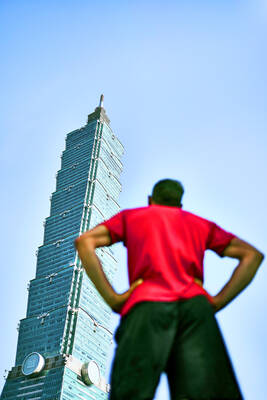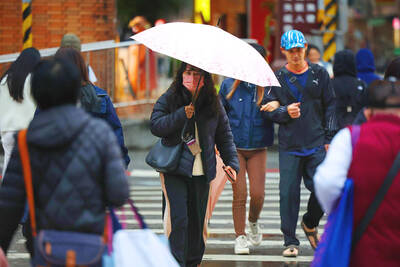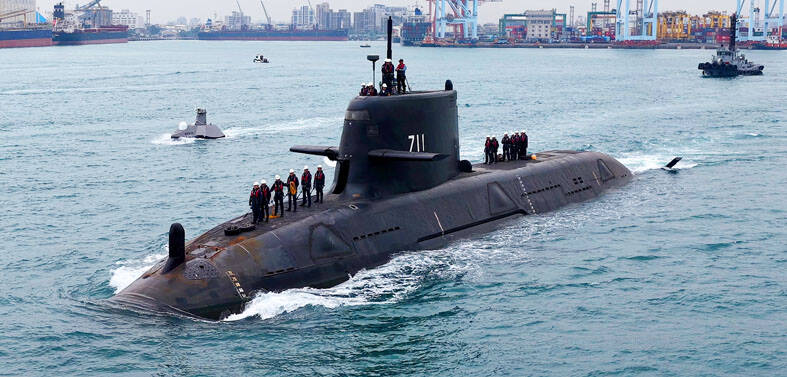Heavy rain from storms and weather fronts over the past month has significantly replenished reservoirs in southern Taiwan, but more is needed for irrigation after the current rainy season ends in November, the Water Resources Agency (WRA) said.
As of 4pm yesterday, the Zengwen Reservoir (曾文水庫), the biggest reservoir in the south, was filled to 67.43 percent of capacity with 341.77 million cubic meters of water.
That was about 260 million cubic meters more than the reservoir held at the same time last month, WRA figures showed.

Photo: Su Fu-nan, Taipei Times
The Wushantou Reservoir (烏山頭水庫) in Tainan, which is connected to the Zengwen Reservoir, was at 72.53 percent of capacity with 57.45 million cubic meters of water, giving the two reservoirs combined reserves of nearly 400 million cubic meters of water, the WRA said.
Meanwhile, as of 4pm yesterday, the Nanhua Reservoir (南化水庫), also in Tainan, had accumulated more than 88.95 million cubic meters of water and was at 99.4 percent of capacity.
Although the Nanhua Reservoir was nearly full, the water there is primarily used for households, while water for agricultural and industrial use is sourced primarily from the Zengwen and Wushantou reservoirs.
Many rice farmers were unable to irrigate their fields during the first two planting seasons in southern Taiwan this year because of the lack of water in the Zengwen and Wushantou reservoirs, and the WRA is hoping the situation will not be repeated next year.
The WRA’s Chianan Irrigation Association (嘉南水利會), which covers the agricultural hubs of Chiayi County and Tainan, said about 40 million to 50 million cubic meters of water is needed for the planting of fall crops and another 200 million cubic meters is needed for next year’s first rice planting season. If water needed for miscellaneous crops next spring is included, the association felt that more water is needed in the two reservoirs to ensure that farmers’ irrigation needs can be met.

US climber Alex Honnold is to attempt to scale Taipei 101 without a rope and harness in a live Netflix special on Jan. 24, the streaming platform announced on Wednesday. Accounting for the time difference, the two-hour broadcast of Honnold’s climb, called Skyscraper Live, is to air on Jan. 23 in the US, Netflix said in a statement. Honnold, 40, was the first person ever to free solo climb the 900m El Capitan rock formation in Yosemite National Park — a feat that was recorded and later made into the 2018 documentary film Free Solo. Netflix previewed Skyscraper Live in October, after videos

NUMBERS IMBALANCE: More than 4 million Taiwanese have visited China this year, while only about half a million Chinese have visited here Beijing has yet to respond to Taiwan’s requests for negotiation over matters related to the recovery of cross-strait tourism, the Tourism Administration said yesterday. Taiwan’s tourism authority issued the statement after Chinese-language daily the China Times reported yesterday that the government’s policy of banning group tours to China does not stop Taiwanese from visiting the country. As of October, more than 4.2 million had traveled to China this year, exceeding last year. Beijing estimated the number of Taiwanese tourists in China could reach 4.5 million this year. By contrast, only 500,000 Chinese tourists are expected in Taiwan, the report said. The report

Temperatures are forecast to drop steadily as a continental cold air mass moves across Taiwan, with some areas also likely to see heavy rainfall, the Central Weather Administration (CWA) said. From today through early tomorrow, a cold air mass would keep temperatures low across central and northern Taiwan, and the eastern half of Taiwan proper, with isolated brief showers forecast along Keelung’s north coast, Taipei and New Taipei City’s mountainous areas and eastern Taiwan, it said. Lows of 11°C to 15°C are forecast in central and northern Taiwan, Yilan County, and the outlying Kinmen and Lienchiang (Matsu) counties, and 14°C to 17°C

STEERING FAILURE: The first boat of its class is experiencing teething issues as it readies for acceptance by the navy, according to a recent story about rudder failure The Hai Kun (海鯤), the nation’s first locally built submarine, allegedly suffered a total failure of stern hydraulic systems during the second round of sea acceptance trials on June 26, and sailors were forced to manually operate the X-rudder to turn the submarine and return to port, news Web site Mirror Daily reported yesterday. The report said that tugboats following the Hai Kun assisted the submarine in avoiding collisions with other ships due to the X-rudder malfunctioning. At the time of the report, the submarine had completed its trials and was scheduled to begin diving and surfacing tests in shallow areas. The X-rudder,